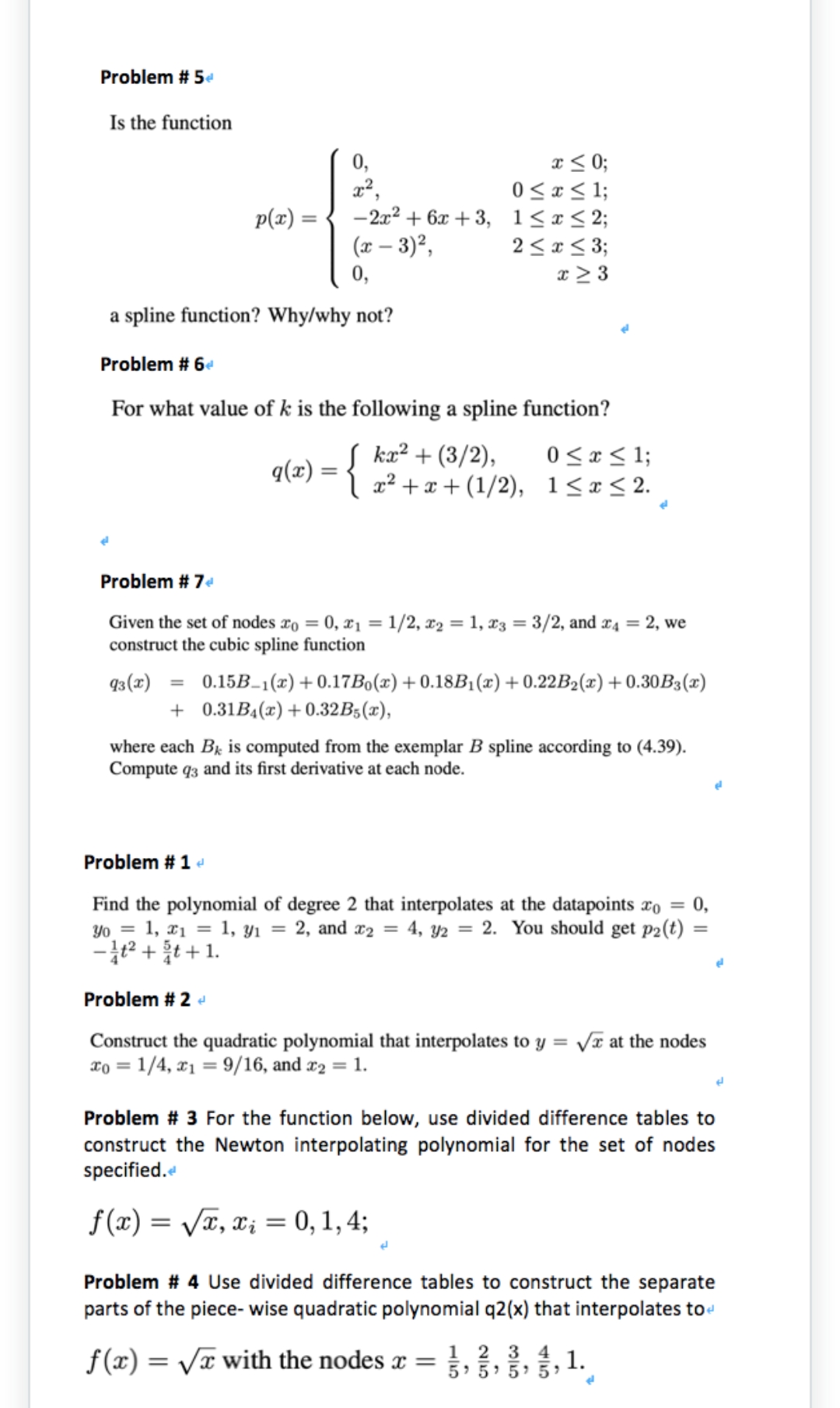Problem # 1 Find the polynomial of degree 2 that interpolates at the datapoints xo = 0, Yo = 1, x1 = 1, y1 2, and r2 = 4, y2 = 2. You should get p2(t) %3D %3D 'I + + za{ - Problem # 2
Problem # 1 Find the polynomial of degree 2 that interpolates at the datapoints xo = 0, Yo = 1, x1 = 1, y1 2, and r2 = 4, y2 = 2. You should get p2(t) %3D %3D 'I + + za{ - Problem # 2
Algebra & Trigonometry with Analytic Geometry
13th Edition
ISBN:9781133382119
Author:Swokowski
Publisher:Swokowski
Chapter3: Functions And Graphs
Section3.5: Graphs Of Functions
Problem 37E
Related questions
Question
solve problem 1 with explanation asap

Transcribed Image Text:Problem # 5e
Is the function
x < 0;
0 < x< 1;
-2x2 + 6x + 3, 1<r< 2;
2 < x < 3;
x > 3
0,
x²,
p(x) =
(x – 3)²,
a spline function? Why/why not?
Problem # 6e
For what value of k is the following a spline function?
0 < x < 1;
kæ² + (3/2),
I 2x² + x + (1/2), 1<x<2.
q(x)
Problem # 74
Given the set of nodes xo = 0, x1 = 1/2, x2 = 1, x3 = 3/2, and x4 = 2, we
construct the cubic spline function
%3D
0.15B–1(x)+ 0.17Bo(x) + 0.18B1(x) +0.22B2(x)+0.30B3(x)
+ 0.31B4(x) +0.32B;(x),
93(x)
%3D
where each Bx is computed from the exemplar B spline according to (4.39).
Compute q3 and its first derivative at each node.
Problem # 1 e
Find the polynomial of degree 2 that interpolates at the datapoints #o = 0,
Yo_ = 1, ¤1 = 1, yi = 2, and x2 = 4, y2 = 2. You should get p2(t)
-2 +t + 1.
%3D
Problem # 2 d
Construct the quadratic polynomial that interpolates to y = Vr at the nodes
To = 1/4, x1 = 9/16, and x2 = 1.
Problem # 3 For the function below, use divided difference tables to
construct the Newton interpolating polynomial for the set of nodes
specified.
f(x) = Va, x; = 0, 1, 4;
%3D
Problem # 4 Use divided difference tables to construct the separate
parts of the piece- wise quadratic polynomial q2(x) that interpolates to
f(x) = Vx with the nodes x =
1 2 3 4
1.
5 5 5' 5
Expert Solution
This question has been solved!
Explore an expertly crafted, step-by-step solution for a thorough understanding of key concepts.
Step by step
Solved in 3 steps with 2 images

Recommended textbooks for you

Algebra & Trigonometry with Analytic Geometry
Algebra
ISBN:
9781133382119
Author:
Swokowski
Publisher:
Cengage

Algebra & Trigonometry with Analytic Geometry
Algebra
ISBN:
9781133382119
Author:
Swokowski
Publisher:
Cengage